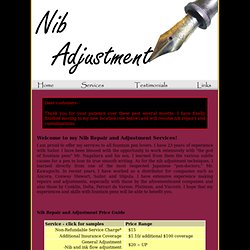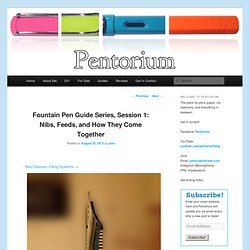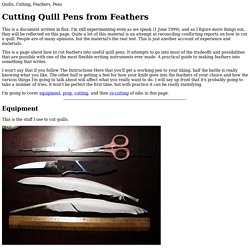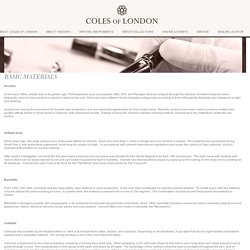

Function and Fabrication of Fountain Pens…shared by One who Did it. Mike It Work! - Nib Adjustment. Dear customers: Thank you for your patience over these past several months.

I have finally finished moving to my new location (see below) and will resume nib repairs and customizations. I am proud to offer my services to all fountain pen lovers. I have 23 years of experience with Sailor. I have been blessed with the opportunity to work extensively with "the god of fountain pens" Mr. Nib Repair and Adjustment Price Guide *Non-refundable service charge will cover return shipment and handling.
General Adjustment: adjusting the nib, tines, and feeder as well as fixing the pen point so as to bring out the pen's true potential.Any adjustment will require a combination of the above. Customers have had good results shipping their pens to Mike-It-Work with USPS Priority Mail with Signature Confirmation. Contact the webmaster © copyright P.D. Call forth a dot… invoke a line… capture a word… express a thought. Nib Tweaking. Nib tweaking by Giovanni Abrate So your pen is a dry writer....

The most common complaint with new fountain pens is that the nib is scratchy or the ink flow is too dry. This article will cover a few methods used to make pens smoother and more reliable writers. Let's start with pens that write dry. There may be several causes that make a pen write dry. First, we will look at tine geometry. So, if you look at your nib and the space between the tines is wider at the tip than it is further back, close to the vent hole, ink will not flow towards the tip. Fountain Pen Guide Series, Session 1: Nibs, Feeds, and How They Come Together. Next Session: Filling Systems -> This is the first in a long list of guides all about fountain pens, ink, and everything that makes a fountain pen what it is.

Fountain pens are one of the most difficult writing instruments to get used to after coming from ballpoints or pencils, and maintaining them can sometimes be just as confusing. This series is designed to help you get the most out of your pens and become versed with what makes them tick. I will also delve into other topics, such as how to buy a fountain pen, how to pick a quality pen, different inks for your pen, and much, much more! Each section will be split up into separate posts, and I will include a table of contents at the top of each post. During these guides I will introduce new words, but don’t worry! Contents. Fountain Pen Repair Restoration and Fountain Pens for Sale. Fine tuning and Adjusting a Nib. Kenro Industries. How to Cut Quill Pens from Feathers. This is a document written in flux.

I'm still experimenting even as we speak (1 June 1999), and as I figure more things out, they will be reflected on this page. Quite a lot of this material is an attempt at reconciling conflicting reports on how to cut a quill. People are of many opinions, but the material's the real test. This is just another account of experience and materials. This is a page about how to cut feathers into useful quill pens. I won't say that if you follow The Instructions Here that you'll get a working pen to your liking, half the battle is really knowing what you like.
I'm going to cover equipment, prep, cutting, and then re-cutting of nibs in this page. Equipment This is the stuff I use to cut quills. Pen Materials. Acrylics In the early 1950s, plastic was in its golden age.

Thermoplastics such as polyester, ABS, PVC and Plexiglas (that are shaped through the injection of melted material) were frequently used to mass produce a variety of items at low cost. There are many different kinds of plastics categorized according to their infrangibility, flexibility, and resistance to light and wearing. Acrylics are among the best resins for fountain pen production, and are especially appreciated for their bright colors. Recently, acrylics have been used to produce mottled and spotted effects similar to those found in celluloid, with impressive results.
Antique Ivory Some years ago, two large antique ivory tusks were offered to Visconti. After careful investigation and tests the first pens were produced and one piece was donated to Pen World Magazine for their 10th anniversary. Bachelite From 1900 until 1960, bachelite was the most widely used material in mass production. Celluloid Ebonite Titanium Volcanic Lava. Welcome to The Pen Connoisseur. I am an Authorized Dealer for Visconti, Bexley, Conway Stewart, Kaweco, Sailor.

If you have questions about specific pens, please contact me. See Deb at a pen show for on site nib work and sales! Cursive Italic Replacement Nib Units For Namiki Vanishing Point Pens Feature: Use and care of the Visconti ink pot Read Deb's March, 2004 Stylophiles article on the Visconti ink pot by clicking here. Richard Binder's Site.